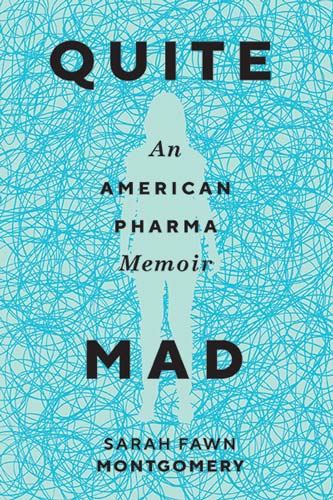Quite Mad
Sarah Fawn Montgomery’s new book, Quite Mad: An American Pharma Memoir, is an in-depth exploration of the ways mental illness is defined and treated, both historically and in the contemporary world. She looks at how our culture simultaneously creates and condemns its maladies, and she offers a glimpse of how the conundrums and contradictions surrounding mental illness can be deconstructed and unraveled.
Sarah Fawn Montgomery’s new book, Quite Mad: An American Pharma Memoir, is an in-depth exploration of the ways mental illness is defined and treated, both historically and in the contemporary world. She looks at how our culture simultaneously creates and condemns its maladies, and she offers a glimpse of how the conundrums and contradictions surrounding mental illness can be deconstructed and unraveled.
Ultimately, Quite Mad tells of Montgomery’s struggle to find agency in a world that constantly tries to take it away. If mental illness and identity are inextricably intertwined, her dilemma is to figure out where her mental illness ends and where she begins.
Over the course of the book, however, Montgomery learns that the best she can do is to embrace the contradictions, uncertainty, and ambiguity that are inevitably a part of human experience. In other words, she both is and is not her mental illness. The only way she finds any measure of peace and strength is through telling her sometimes confused and confusing story. Learning to make meaning through narration, in other words, becomes a vital survival strategy.
In the book’s opening prologue, she lays out the basic conditions of her mental life:
I have generalized anxiety disorder, which means I live a socially stigmatized existence ruled by chronic fear and worry, my stress over lack of sleep or bills or work twisting itself in my psyche until it manifests as constant distress, irritability, restlessness, catastrophic paranoia, and strange delusions.
In the first half of the book, she goes into detail about her chaotic childhood, describing how her parents constantly adopt and foster children and never have enough time or energy to devote to her and her needs. It becomes clear—to the reader, to Montgomery’s therapist, and eventually to Montgomery herself—that this childhood helped to create the anxiety that would eventually become debilitating.
It takes her many years and pages, however, to make this connection. In the intervening time, she gives an account of her experiences with a series of antidepressants, as she tries and fails to find one that lets her feel “normal,” even as she repeatedly comes up against difficult and life-altering side effects.
Interspersed with this personal story is a fascinating look at the history of mental illness, with its categories and cures, and the ways that each era creates its own notions of health and illness, along with its own cures—from the rest cure to lobotomies to, in the last half of the twentieth century, the psychotropic medications that Montgomery found herself wrestling with.
It’s not until she discovers talk therapy and her long-time therapist, Gail, that her headlong rush through the maddening complexities and blindnesses of psychiatry slows down, allowing her to take a breath, look inward, and start to tell her story.
Through the storytelling work involved in talk therapy, finally, she begins to heal. As she says near the end of the book:
I learned there is no set narrative. That’s what therapy offers—choice, agency, the knowledge that nothing is permanent. Where contradiction was frowned upon by people who could not tolerate my inability to be “cured,” therapy rewards complexity. It broadens the definition of normal.
Through therapy and the narratives it helps her create, Montgomery discovers a sense of identity and agency that had eluded her up to that point. Therapy, she says, “allows us to be messy and imperfect (and anxious), reminding us that people are endlessly complicated, a lesson that is undeniably healing.”
She also discovers that in conjunction with therapy, she can continue to take medication—but this time on her own terms, and with a healthy dose of humor and humanness that lets her live her life, experience her emotions, and even deal with the side effects that had at one time been overwhelming. Part of the transformation is that she learns that drugs are not necessarily, in themselves, bad or good:
For the first time since I’ve been diagnosed, my body, my illness, my sanity are not the center of my narrative. Neither are drugs, which I’ve come to see differently. Just as I am neither hero nor villain, nor my parents who have tried their best, neither are drugs. For as many stories of adverse reactions, there are stories of success. Drugs have helped me after all.
What’s changed, she proposes, is that she now has a sense of being herself, with all of the ambiguity and interplay of health and illness that that identity suggests.
This is an inspiring book that recounts a journey that many people in the highly-medicated twenty-first century are on, and it offers hope to all of us. We’re both our health and our illnesses, as well as the stories we manage to tell.





